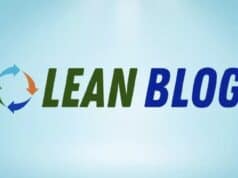TPS – Lean Manufacturing and Process Improvements: Lean Articles
Here is a good article from Bill Hanover, President of ThroughPut Solutions. Bill previously wrote a series of articles on lean management, “Mere Mortal Managers”, which I also recommend highly.
Bill makes a good point that “lean” solutions don't always have to involve fancy technology or spending money. I agree that quick, simple solutions based on materials you have on hand can be very rewarding to a team. Let's think about being part of a kaizen event. If your team has an idea for improving something, is it more rewarding to wait for 3-4 weeks for something to arrive from a catalog, or to put a fix in place right now?
I think it's also worth emphasizing Bill's point that you should be fixing problems. I often times run into co-workers who want to “push” technology. “Wouldn't it be helpful if we put in RFID scanners?” they'll ask. My response usually is “What is the existing process? Can we improve the existing process (or define it) and put other error proofing in place without the technology?”
Check out Bill's article. If you have comments, you can post them here (Bill reads this blog).
Please scroll down (or click) to post a comment. Connect with me on LinkedIn.
Let’s build a culture of continuous improvement and psychological safety—together. If you're a leader aiming for lasting change (not just more projects), I help organizations:
- Engage people at all levels in sustainable improvement
- Shift from fear of mistakes to learning from them
- Apply Lean thinking in practical, people-centered ways
Interested in coaching or a keynote talk? Let’s talk.
Join me for a Lean Healthcare Accelerator Trip to Japan! Learn More








Great article that brings up a good point about software as well. Too many applications seek to solve the software problem without focusing on usability – and not just usability of individual screens, but the entire process as well.
I worked for an IT director at a manufacturing plant years ago that always pushed back on software implementations. His point was that if you’re going to automate a process, don’t just duplicate the existing process – streamline it and make it better. It was my first job out of school and I didn’t realize at the time how foreign that approach is. This seems pretty simple, but it’s amazing how often software projects look at the manual method and simply attempt to duplicate it. It’s a really bad place to start.
I hit submit too soon…
A great analogy for good software design vs. bad software design is Quickbooks vs. Great Plains. (I’m not really picking on Great Plains as I’m picking on the entire accounting software category including Peachtree and others.)
Quickbooks *owns* the small business market. Why? Because Quickbooks works the way its intended audience works. When I take in a check, I record it in quickbooks rather than having to conceptually understand where the debit and corresponding credit have to take place. Every accountant I’ve ever talked to qualifies Quickbooks as a dirty system because it doesn’t follow their “process” as it’s taught in school. Bottom line, these competing packages live (and die) by pressing a data/software model over usability and that simply doesn’t work well for their customers.
That said, take a look at the lean software market. The problem is identical – nearly all are prioritizing software/data issues first and the user second. The accounting software analogy is timely here because nearly every system in the Lean mfg market approaches the problem from an ERP/Accounting background.
Talking about QuickBooks (good analogy by the way). Here is a product that handles processes in an intuitive way not unlike quickbooks. This package approaches accounting from the GL as well as the client customer site. Very valid points. Love to know what you think.
http://darwinproductions.net
Damian,
I like what I’m seeing at your site and I need to look to see if you have an evaluation mode available. I’ll dig in more and be in contact.
Thanks,
-Steve
Would love to show you what we do and possibly give you a “press” copy.
Talk soon.
http://darwinproductions.net
Comments are closed.